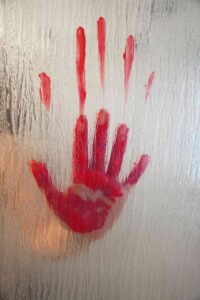Psycho, the movie directed by Alfred Hitchcock, is a timeless classic that revolutionised the thriller genre of filmmaking. Released in 1960 on a shoestring budget of just $807,000 the movie was not only a massive box office success, but it also left a lasting impact on the way creepy music was used in movies right up to today.
One of the most well known and iconic elements of Psycho is its music score, composed by Bernard Herrmann. Lets delve into the world of Psycho’s music, take a look at how Herrmann’s score created one of the most iconic and creepy soundtracks in film history and look at how this has impacted modern film scores.
Herrmann had previously worked with Hitchcock on movies such as Vertigo and North by Northwest and was tasked with creating a score that would match the intensity and suspense of the movie. Hitchcock was known for his meticulous attention to detail, and the music score was no exception to this. The director wanted a music score that would create an atmosphere of a creepy unease and tension, and Herrmann was the man for the job.

The opening of the movie sets the tone for what is to come. The title sequence, designed by Saul Bass, features an iconic split-screen effect, with the names of the cast and crew appearing on screen in time with the music. Herrmann’s score for the title sequence is haunting and creepy, with strings playing a high-pitched melody that gradually builds in intensity. The music is punctuated by sharp, stabbing notes that add to the feeling of unease.
Of course anyone who has seen the movie will remember the shower scene. Herrmann’s score for the shower scene is a masterpiece of tension and suspense. The music is composed of a series of screeching, high-pitched notes that are played on violins and violas. The screeching notes are interspersed with periods of silence, which only serve to heighten the tension. The effect is so effective that even today, over 60 years after the movie’s release, the sound of the screeching violins is instantly recognisable.
Herrmann’s use of the strings section in Psycho is particularly noteworthy. The composer used a technique known as “col legno,” which involves striking the strings of the instrument with the wood of the bow instead of the hair. This creates a distinctive clicking sound that is reminiscent of the sound of insects or rodents scurrying around. It is an effect that is eerie and unsettling, adding to the overall feeling of creepiness that permeates the movie.
Another example of Herrmann’s masterful use of music to create a creepy atmosphere can be found in the scene where Norman Bates carries his mother’s corpse down to the fruit cellar. The music in this scene is slow and mournful, with the strings section playing a melancholy melody. The effect is both sad and disturbing, adding to the sense of unease that the audience feels as they watch the scene unfold.
Herrmann’s music score for Psycho was groundbreaking in many ways at the time. The composer used many unconventional techniques and instruments to create a sound that was unlike anything heard before in movies. The score was also notable for its use of silence, with Herrmann recognising that sometimes the absence of music can be just as effective as its presence. This in itself is a technique employed by many modern day filmmakers. The sound of silence often evokes more atmosphere than sound or music itself. Examples of movies that use little to no sound in them can be found here.
Herrmann’s use of repetition was also noteworthy in the music score for Psycho. In many scenes, Herrmann repeats the same melody over and over, gradually increasing the tempo and/or intensity. This technique serves to heighten the tension and create a sense of impending doom. The repetition of the same melody also creates a sense of familiarity, which makes it all the more unsettling and creepy when the melody suddenly changes.
The music score for Psycho also plays an important role in shaping of the character Norman Bates. Herrmann’s score uses a number of different motifs to represent Norman’s different personalities. For example, the music that plays when Norman is talking to Marion Crane in the parlour is light and whimsical, reflecting his affable and friendly persona. However, when Norman’s true nature is revealed, the music changes dramatically, becoming much darker and more sinister.
Herrmann’s music score for Psycho was so effective that it became a template for future horror movies. Many filmmakers have since tried to replicate the same sense of tension and unease that Herrmann’s music was able to achieve. Some have even used the same instrumentation and techniques, such as the col legno technique, to create a similar sound.
The music score for Psycho has also had a significant impact on popular culture. The shower scene music, in particular, has become one of the most recognisable pieces of film music in history. It has been used in countless parodies, homages, and references in movies, TV shows, commercials and across YouTube and social media.
In addition, the music score for Psycho has influenced a whole generation of filmmakers and composers. Herrmann’s use of unconventional instrumentation and techniques opened up new avenues for film music scores. His work has inspired countless other composers to experiment with new sounds and styles in their own scores.
Herrmann’s music score for Psycho also highlights the importance of collaboration between the director and composer in filmmaking. Hitchcock and Herrmann had a close working relationship, and their collaboration on Psycho was particularly fruitful. The director’s vision for the film and the composer’s musical talents combined to create a truly memorable cinematic experience.
The score for Psycho is a testament to the power of film music to shape mood, emotion, and character. Bernard Herrmann’s innovative use of instrumentation, repetition, and silence created a creepy and unsettling atmosphere that perfectly matched the tone of the movie. His music score has had a lasting impact on popular culture and continues to inspire filmmakers and composers to this day. The creepy music of Psycho is a reminder of the important role that film music plays in the art of filmmaking, and it remains a classic example of how music can elevate a film to a whole new level.

